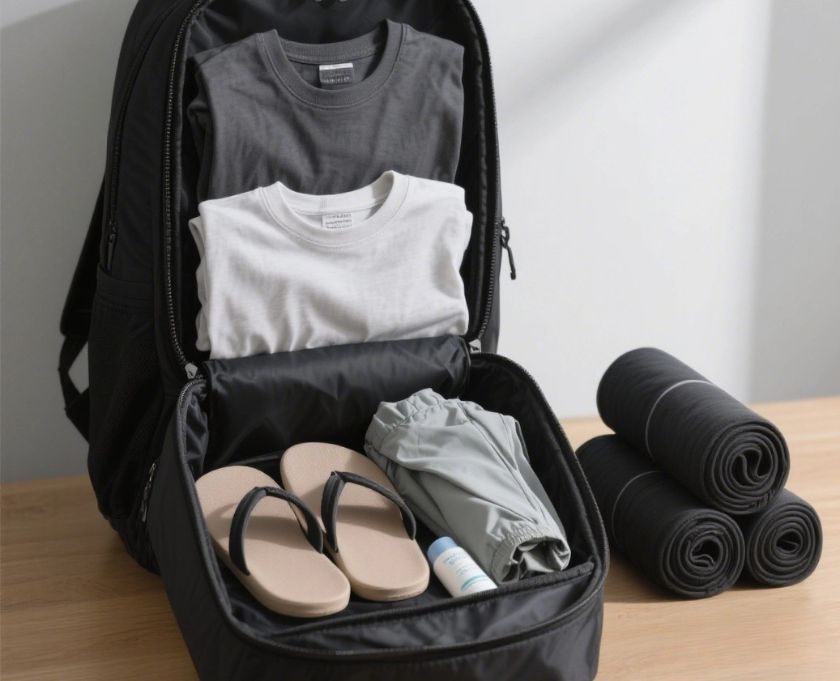Beautiful Plants For Your Interior

Backpacking travel demands a fine balance between comfort, efficiency, and mobility. Unlike suitcase travel, where you can throw in extra outfits, backpacking requires smart use of limited space.
Efficient packing is not just about fitting everything in — it’s about:
- Keeping your backpack light enough for long treks;
- Ensuring quick access to essentials;
- Protecting fragile items;
- Maximizing available space.
This guide will share proven space-saving packing techniques, explore gear and tools to optimize storage, and provide practical examples for different backpack sizes (20L, 40L, and 60L+).
Core Space-Saving Packing Strategies
1. Rolling vs. Folding Clothes
- Rolling: Best for T-shirts, jeans, light jackets. Saves 20–30% space.
- Folding: Best for formal shirts, structured garments. Prevents wrinkles.
- Pro Tip: Combine rolling for casual wear + folding for formal wear.
2. Compression Bags
- Use: Remove air from bulky clothing like jackets and sweaters.
- Best For: Cold-weather trips.
- Warning: Don’t over-compress; can increase backpack density and discomfort.
3. Packing Cubes (Modular System)
- Function: Separate clothing categories, making unpacking easier.
- Types: Standard cubes, compression cubes, waterproof cubes.
- Pro Tip: Use different colors for clothing, toiletries, and electronics.
4. Layering and Modular Systems
- Concept: Pack clothing that works in layers instead of bulky single items.
- Example: Instead of a heavy coat, bring a base layer + fleece + windbreaker.
5. Ultralight Travel Essentials
- Quick-dry clothing
- Multi-use scarves / sarongs
- Travel-size toiletries
- Microfiber towel
Backpack Size-Specific Packing
1. 20L Backpack (Minimalist / Weekend Trips)
- 2–3 shirts (rolled)
- 1 pair of pants + 1 shorts
- 3 sets of underwear/socks
- Compact toiletries
- Electronics: phone + small charger
- Tip: Stick to essentials; use ultralight gear.
2. 40L Backpack (Standard Carry-On Travel)
- 5–7 shirts
- 2 pants + 1 shorts
- 1 lightweight jacket
- 5–7 underwear/socks
- Toiletries in 100ml bottles
- Laptop/tablet
- Tip: Use compression cubes to separate outfits.
3. 60L+ Backpack (Long-Term Travel)
- 7–10 shirts
- 3 pants + 2 shorts
- Layering jacket + fleece
- 7–10 underwear/socks
- Toiletries + first-aid kit
- Electronics: laptop, chargers, camera gear
- Tip: Use top-loading packing strategy: least-needed items at bottom, daily essentials at top.
Smart Packing Hacks for Extra Space
- Stuff socks inside shoes to use dead space.
- Use carabiners to clip gear outside the backpack (water bottle, sandals).
- Wear bulkier clothing (jackets, boots) during travel days.
- Use travel-size solid toiletries (soap bars, shampoo bars) instead of liquids.
- Adopt the 1-2-3-4-5 Rule:
- 1 hat
- 2 pairs of shoes
- 3 bottoms
- 4 tops
- 5 pairs of underwear/socks
Space Optimization Tools
| Tool | Function | Best For |
|---|---|---|
| Compression Bags | Reduce air from clothing | Winter clothing |
| Packing Cubes | Organization + space control | Any backpack |
| Vacuum Sealer | Max compression (not always practical) | Checked luggage |
| Stuff Sacks | Compress sleeping bags, jackets | Outdoor trips |
| Elastic Straps | Bundle items tightly | Minimalist travelers |
Common Mistakes to Avoid
- Overpacking “just in case” items.
- Carrying duplicate toiletries.
- Ignoring weight distribution (heavier items at bottom).
- Not planning outfit coordination (stick to neutral colors).
FAQ — Space-Saving Packing
Q1: Is rolling clothes always better than folding?
A1: Rolling saves space, but folding prevents wrinkles. Use both depending on the garment.
Q2: Can packing cubes really save space?
A2: Yes — especially compression cubes, which reduce bulk by 30–40%.
Q3: Should I use vacuum seal bags for backpacking?
A3: Only for checked luggage or very bulky clothing. For daily backpacking, compression cubes are more practical.
Q4: How to avoid overpacking?
A4: Plan outfits in advance, adopt minimalist rules, and avoid duplicate items.
Conclusion
Efficient backpack packing is both an art and science. By using rolling techniques, modular packing cubes, compression systems, and minimalism principles, you can:
- Save up to 40% backpack space;
- Travel lighter and more comfortably;
- Stay organized throughout your trip.
👉 Remember: A well-packed backpack = a stress-free adventure.